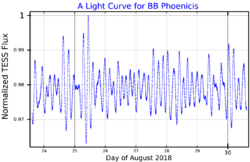Astronomy:BB Phoenicis
| Observation data Equinox J2000.0]] (ICRS) | |
|---|---|
| Constellation | Phoenix |
| Right ascension | 00h 30m 27.825s[2] |
| Declination | −40° 56′ 22.51″[2] |
| Apparent magnitude (V) | 6.18[3] |
| Characteristics | |
| Spectral type | F0/2III[4] |
| Variable type | δ Scuti[3] |
| Astrometry | |
| Radial velocity (Rv) | −3.6[5] km/s |
| Proper motion (μ) | RA: −3.40[2] mas/yr Dec.: 16.95[2] mas/yr |
| Parallax (π) | 7.2816 ± 0.0397[2] mas |
| Distance | 448 ± 2 ly (137.3 ± 0.7 pc) |
| Absolute magnitude (MV) | 0.57±0.20[6] |
| Details[6] | |
| Mass | 2.25±0.10 M☉ |
| Radius | 4.7±0.3 R☉ |
| Luminosity | 55.2+5.4 −9.3 L☉ |
| Surface gravity (log g) | 3.44±0.03 cgs |
| Temperature | 7,200±100 K |
| Rotation | 2.17 days |
| Rotational velocity (v sin i) | 82±2 km/s |
| Other designations | |
| Database references | |
| SIMBAD | data |
BB Phoenicis is a variable star in the constellation of Phoenix. It has an average visual apparent magnitude of 6.17,[3] being visible to the naked eye with excellent viewing conditions. From parallax measurements by the Gaia spacecraft, it is located at a distance of 448 light-years (137 parsecs) from Earth.[2] Its absolute magnitude is calculated at 0.6.[6]
BB Phoenicis is a Delta Scuti variable, and shows stellar pulsations that cause brightness variations with an amplitude of 0.04 magnitudes.[3] Its variability was discovered by accident in 1981, when the star was used as a comparison star for the eclipsing binary AG Phoenicis.[8] Photometric and spectroscopic data have allowed the detection of at least 13 modes of radial and non-radial pulsations, the strongest one having a period of 0.174 days and an amplitude of 11.1 milli-magnitudes. Observations in different epochs show evidence that the pulsations modes vary in amplitude, which is common among Delta Scuti variables. Pulsation models indicate that the stellar rotation axis is inclined by 50–70° in relation to the line of sight.[9]
This star is classified as an F-type giant with a spectral type of F0/2III.[4] It appears to be expanding after depleting all the nuclear hydrogen and leaving the main sequence.[6] BB Phoenicis has an estimated mass of 2.25 times the solar mass and a radius of 4.7 times the solar radius. It is radiating 55 times the Sun's luminosity from its photosphere at an effective temperature of 7,200 K.[6]
References
- ↑ "MAST: Barbara A. Mikulski Archive for Space Telescopes". Space Telescope Science Institute. https://mast.stsci.edu/portal/Mashup/Clients/Mast/Portal.html.
- ↑ 2.0 2.1 2.2 2.3 2.4 2.5 Brown, A. G. A. (August 2018). "Gaia Data Release 2: Summary of the contents and survey properties". Astronomy & Astrophysics 616: A1. doi:10.1051/0004-6361/201833051. Bibcode: 2018A&A...616A...1G. Gaia DR2 record for this source at VizieR.
- ↑ 3.0 3.1 3.2 3.3 Samus', N. N; Kazarovets, E. V; Durlevich, O. V; Kireeva, N. N; Pastukhova, E. N (2017), "General catalogue of variable stars: Version GCVS 5.1", Astronomy Reports 61 (1): 80, doi:10.1134/S1063772917010085, Bibcode: 2017ARep...61...80S.
- ↑ 4.0 4.1 Houk, N. (1987). "Michigan atalogue of two dimensional spectral types for the HD stars, Vol. 2". Michigan Spectral Survey 2. Bibcode: 1978mcts.book.....H.
- ↑ Gontcharov, G. A. (November 2006), "Pulkovo Compilation of Radial Velocities for 35495 Hipparcos stars in a common system", Astronomy Letters 32 (11): 759–771, doi:10.1134/S1063773706110065, Bibcode: 2006AstL...32..759G.
- ↑ 6.0 6.1 6.2 6.3 6.4 Bossi, M.; Mantegazza, L.; Nunez, N. S. (1998). "Simultaneous intensive photometry and high resolution spectroscopy of δ Scuti stars. III. Mode identifications and physical calibrations in HD 2724". Astronomy and Astrophysics 336: 518. Bibcode: 1998A&A...336..518B.
- ↑ "BB Phe". SIMBAD. Centre de données astronomiques de Strasbourg. http://simbad.u-strasbg.fr/simbad/sim-basic?Ident=BB+Phe.
- ↑ Reipurth, B. (1981). "Two New Variable Stars in the Bright Star Catalogue". Information Bulletin on Variable Stars 2015: 1. Bibcode: 1981IBVS.2015....1R.
- ↑ Mantegazza, L.; Poretti, E. (1999). "Line profile analysis of the δ Scuti star HD 2724 = BB Phe: Mode identification and amplitude variations". Astronomy and Astrophysics 348: 139. Bibcode: 1999A&A...348..139M.
 |

